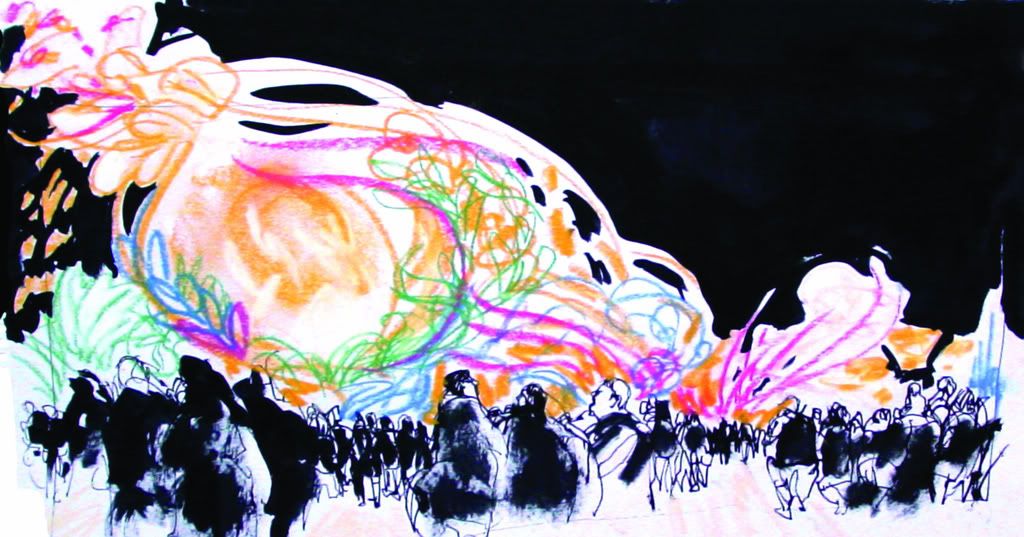Carousel!
Angel of the Waters, Central Park

The fountain in the "heart of Central Park" commemorates the 1842 opening of the Croton Aqueduct, which was the first dependable supply of pure water in New York City. The original pool of Bethesda in Jerusalem was said to have had healing powers.
I was going more for the feeling of the fountain and Central Park rather than a straight forward drawing, although I tried to keep the original reason for the fountain in mind.
The Signs of Flushing, Queens
Moonlit Night
Life Drawing
Animal Kingdom Reportage
Animal Kingdom Parade Stamps
Animal Kingdom Parade
Remember Olafur?
Transformation
Night Parade
Dionysus Mural
Dionysus, the Greek god of wine, revelry, madness, and ecstasy is a perfect figure for artists since he's all about unbridled license and a freeing from the normal constraints of everyday life and civilization. The cult of Dionysus were the first to try to transcend the existence of the flesh. During the rites, the initiates of the cult were supposed to actually take the god into themselves - to become the god.
The theme of the mural was "change," and I wanted to depict something cyclical instead of a one-way transformation. Dionysus is called the twice-born god because he was born from both his mother and his father. His mother, Semele, asked to see Zeus undisguised, the same way he came before Hera. Zeus had promised Semele anything she wanted, so he reluctantly showed himself, in his least awful incarnation. Semele was immolated completely anyway, and Zeus couldn't do anything for her except to pluck Dionysus, then in utero, from her ashes. Since the fetus hadn't been fully brought to term, Zeus sewed him into his thigh, from which he birthed him a few months later. The death of Semele is on the left side of the mural, and Dionysus' birth is depicted on the right. In the middle is the ritual bacchanal (and death) of the god, who is sacrificed and resurrected yearly. Dionysus leads the procession of initiates, dancing in drunken ecstasy. The bull that is sacrificed stands in for the god. Strangely enough, Dionysus is both a celebrant and the sacrifice in the ritual.
Whew! So that's the story, here's the mural:

And some details:




The theme of the mural was "change," and I wanted to depict something cyclical instead of a one-way transformation. Dionysus is called the twice-born god because he was born from both his mother and his father. His mother, Semele, asked to see Zeus undisguised, the same way he came before Hera. Zeus had promised Semele anything she wanted, so he reluctantly showed himself, in his least awful incarnation. Semele was immolated completely anyway, and Zeus couldn't do anything for her except to pluck Dionysus, then in utero, from her ashes. Since the fetus hadn't been fully brought to term, Zeus sewed him into his thigh, from which he birthed him a few months later. The death of Semele is on the left side of the mural, and Dionysus' birth is depicted on the right. In the middle is the ritual bacchanal (and death) of the god, who is sacrificed and resurrected yearly. Dionysus leads the procession of initiates, dancing in drunken ecstasy. The bull that is sacrificed stands in for the god. Strangely enough, Dionysus is both a celebrant and the sacrifice in the ritual.
Whew! So that's the story, here's the mural:

And some details:




Olafur Eliasson at Moma
I went to the Olafur Eliasson's Take Your Time at Moma and was inspired to make some drawings at the show. If you've been to the show, you can probably tell which piece inspired which drawing.



 I like them because they are drawings that help me understand what's happening - drawings made to figure something out and explain.
I like them because they are drawings that help me understand what's happening - drawings made to figure something out and explain.



 I like them because they are drawings that help me understand what's happening - drawings made to figure something out and explain.
I like them because they are drawings that help me understand what's happening - drawings made to figure something out and explain.













